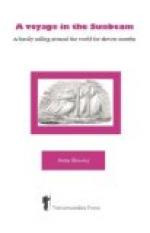Seeing smoke in the distance, rising from under some high palm-trees, we thought we should like to go and see whence it proceeded, and accordingly set off to walk through a sort of bush, over sharp coral that cut one’s boots terribly, the sun blazing down upon us fiercely all the time, until we reached a little settlement, consisting of several huts, the inhabitants of which were absent. Fine plaited mats for beds, cocoa-nut shells for cups, mother-of-pearl shells for plates, and coral, of various kinds and shapes, for dishes and cooking utensils, formed their only furniture. We saw three women, one very old, with nothing but a palm-leaf mat as a covering, the others dressed in the apparently universal costume, consisting of a long bright-coloured gown, put into a yoke at the shoulders, and flowing thence loosely to the ground, which completely conceals the wearer’s form, even to the tips of her toes. I think these dresses must come from England or America, for they are evidently machine-made, and the cotton-stuft of which they are composed has the most extraordinary patterns printed on it I ever saw. Cherry and white, dark blue and yellow or white stripes, red with yellow spots, and blue with yellow crosses, appear to be the favourite designs. The women seemed gentle and kind, and were delighted with some beads, looking-glasses, and knives I gave them, in return for which they brought us quantities of beautiful shells.
We saw the large iron knee of a vessel in one spot during our walk, and wondered how it came there. In another place we saw a canoe in process of construction, ingeniously made of boards, sewed together with plaited palm-leaves. The canoes in use here are very high, long, and narrow, and are only kept from upsetting by means of a tremendous outrigger, consisting of a log fastened to the extremity of two bent pieces of wood, projecting sideways from each end of the boat. The only animals we met with in our ramble were four pigs and a few chickens, and no other live stock of any kind was visible. No attempt seemed to be made at the cultivation of the ground; and I think, if there had been, we must have observed it, for our party separated and walked a good distance in various directions.
The natives made us understand that on the other side of the entrance to the lagoon, in the better sort of house we had noticed, there resided a white man. He did not, however, make his appearance during our visit, and I imagine he must have been one of those individuals called ‘beach-combers,’ referred to in so many of the books that treat of the South Sea Islands,—a sort of ne’er-do-well Englishman or American, rather afraid of meeting any of his own countrymen, but very clever at making a bargain between a ship’s crew and the natives, with considerable profit to himself.




